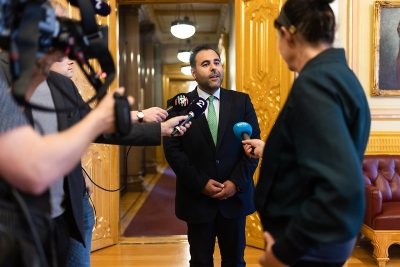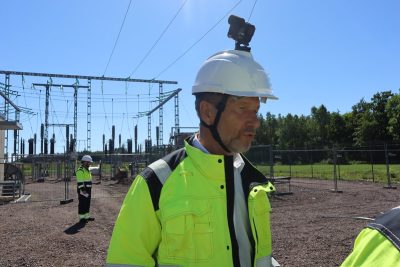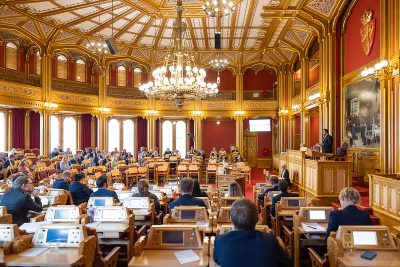NEWS ANALYSIS: Sparks have been flying for months over an ongoing rise in Norway’s once-low electricity rates. They’ve been setting new records in some portions of the country nearly every day, even during the summer when demand is low. Now Members of Parliament and the government have been called in to formally address the paradox of what they call an “energy crisis” in a country known for its oil, gas and abundant hydroelectric resources.

“The power situation is serious,” Parliament’s President Masud Gharahkhani told reporters after summoning MPs to what will be their first extraordinary session in more than a decade. He claimed his own Labour Party-led minority coalition government with the Center Party is taking the situation seriously: “Now we will show that we (the government and Parliament) are working together for Norwegian residents and businesses in the times we’re in.”
The meeting due to take place in mid-September is controversial itself, however, since Oil & Energy Minister Terje Aasland of the Labour Party had stated as late as Monday that he didn’t think an extraordinary session of Parliament is necessary. Both Labour and the Conservative Party, along with several other parties, agree that Norwegian businesses should now receive some form of compensation from the state to offset their extraordinary electricity costs, which have more than quadrupled for many. Norwegian households have been receiving compensation since last winter and that will continue into next year.
Opposition parties in Parliament, however, continued to complain that relief for Norwegian businesses wasn’t coming quickly enough, nor was it clear what form it would take. That prompted the Parliament’s leadership to ask Aasland and his ministry for a time plan for new measures aimed at offering relief. Progress Party leader Sylvi Listhaug seized the opportunity to claim that resorting to an extraordinary session was thus “embarrassing” for both Aasland and the government itself.
Aasland had responded to Parliament’s concerns in letters last week and on Monday that offered “an evaluation of the status and perspectives for the power situation this winter” and an “orientation of a time plan for the measures the government is working with.” He admitted to “uncertainty” over how Norway’s electricity supplies would develop in the months ahead, not least because many of the country’s own reservoirs have fallen below normal levels after an unusually dry winter, spring and summer.

Some reservoirs, however, are spilling over both in Northern Norway and some mountain regions of Western Norway where it’s rained most of the summer. That raises lots of questions about how hydroelectric power is managed and distributed, and why electricity rates can vary enormously within Norway itself. Residents in the south are getting much higher bills than in the north, and there even are huge differences between neighbouring “power zones” within the southwestern portion of the country.
The mayor of Høyanger in the mountainous county of Sogn og Fjordane, notably from the government’s own Center Party, has complained over how residents south of the fjord (including himself) were paying much higher rates than those on the north side. “Try to understand that if you can!” exclaimed Mayor Geir Helge Østerbø to newspaper Dagsavisen late last week. “Never before has more electricity been produced here, and it’s rained absolutely the whole summer, but we’re still paying the highest electricity rates in the world!” On Wednesday, Dagsavisen reported that electricity rates in Southern Norway were 400 times higher than in Northern Norway.
The government’ plan sent to Parliament on Monday would boost compensation to households in September, evaluate extra support for students and pinpoint the needs of various businesses and “find suitable measures” to help offset higher energy costs. The plan was also meant to “secure electricity supplies” through a new “steering mechanism” that would require electricity producers to save more water in their reservoirs and even “limit” electricity exports when reservoirs fall below a certain level. That means a potential reversal of earlier export policy aimed at helping Europe cope with the loss of gas supplies tied to Russia’s war on Ukraine.
Aasland noted that Norway’s hydroelectric systems comprise “many types of power plants and reservoirs” from which electricity is “distributed in various ways” around the country. “The power system nonetheless hangs together tightly, and measures in one region can affect the power situation in another region,” he wrote. Efforts to even out electricity rates will take time, but some answers are expected this autumn. Other measures aimed at higher energy conservation and “more efficient consumption” among the public will be outlined in the state budget to be presented in October.

A majority in Parliament didn’t think Energy Minister Aasland’s response was good enough, resulting in the extraordinary session for more political debate in Parliament. Aasland has continued to claim that some conservation measures are already working, reservoir levels have been rising and the public needs to save electricity, too. Other MPs are skeptical, with, for example, the Conservatives wanting more and quicker details on support for businesses, the Progress Party calling for removal of taxes and fees on electricity, the Socialist Left (SV) and the Reds wanting “more political and democratic control” over the power supply, and several parties calling for cuts in electricity exports. The Greens Party, meanwhile, is most concerned with energy conservation measures.
Some parties, including the Greens, Labour and the Conservatives in Oslo’s city government are suggesting new power lines to better connect supplies in the north and the south. There have also been calls to impose a maximum rate on electricity and to halt ongoing projects to electrify Norway’s offshore oil platforms (in order to preserve more electricity for mainland industry, businesses and households).
Prime Minister Jonas Gahr Støre has been on the defensive lately, repeatedly claiming that his government will “do what we can” to offer some relief from extraordinarily high monthly electricity bills. He’s been warning for months that a tough winter looms, while the threat of electricity rationing has been raised, something unheard of in an energy-producing country like Norway. This week Støre, often criticized for wavering on issues, even backtracked on earlier refusals to cut electricity exports to Europe. Now he’s suggested they may be “limited” if water levels in reservoirs fall below a certain level, a new position that some political commentators view as a way of appeasing his government partner since the Center Party has long criticized energy exports apart from gas and oil.
Others including former Labour Prime Minister Jens Stoltenberg, now head of NATO, have also been stressing that the currently high electricity rates are part of the price Norwegians, most Europeans and others around the world are paying after Russia invaded Ukraine. The Ukrainians, meanwhile, are paying a much higher price in human life and misery every day. Some view the high rates, and the need to conserve energy, as simply part of Norway’s and Europe’s support for Ukraine and think Norwegians should stop complaining.

The debate over Norway’s electricity rates, and how to lower them again, is also flying within business, industry and the media, with several leading players disagreeing on what the state’s role should be. Some industrial giants like Elkem and Norsk Hydro are at odds themselves over what’s needed, or even whether the state should provide any relief.
Editorials in newspapers Aftenposten and Dagsavisen have unusually agreed that the government and Parliament should be careful about providing too much assistance to those complaining. “There’s an understandable impulse,” wrote Dagsavisen, for households and businesses “to ask for help from a wealthy state.” The compensation doled out during the Corona crisis received broad support, mostly because the state ordered shutdowns and needed to compensate for the losses they created, but now the state shouldn’t help out too much, warned the paper that’s a strong defender of the social welfare state: “There’s an energy crisis underway and we all must adapt to it, without expecting that Mother State covers all the extra costs while we go on living as before.” The paper also editorialized that electrification of offshore oil platforms “must continue” for climate reasons, and that energy conservation measures should take top priority.
Others note that the high electricity rates and the inflation also taking hold in Norway reflect the price one must pay in a free market society. “Businesses should pay their electricity bills themselves,” headlined Aftenposten’s editorial on the issue over the weekend. Norway’s economy has remained strong through both the Corona crisis and the war, with the paper noting how the national employers’ organization representing business (NHO) usually argues that the use of state funds must be limited.
“But not when it benefits companies, apparently,” Aftenposten editorialized. “The state is formed by the people, not businesses, which also operate within markets. Most businesses can also pass on their costs to customers. Therefore the government should be extremely careful in coming forward with state assistance once again, especially when the private sector has mostly been doing very well.”
That was written before the Parliament also got involved. Aftenposten recommended limiting any electricity compensation to offers of state-guaranteed loans for those businesses struggling the most.
newsinenglish.no/Nina Berglund

